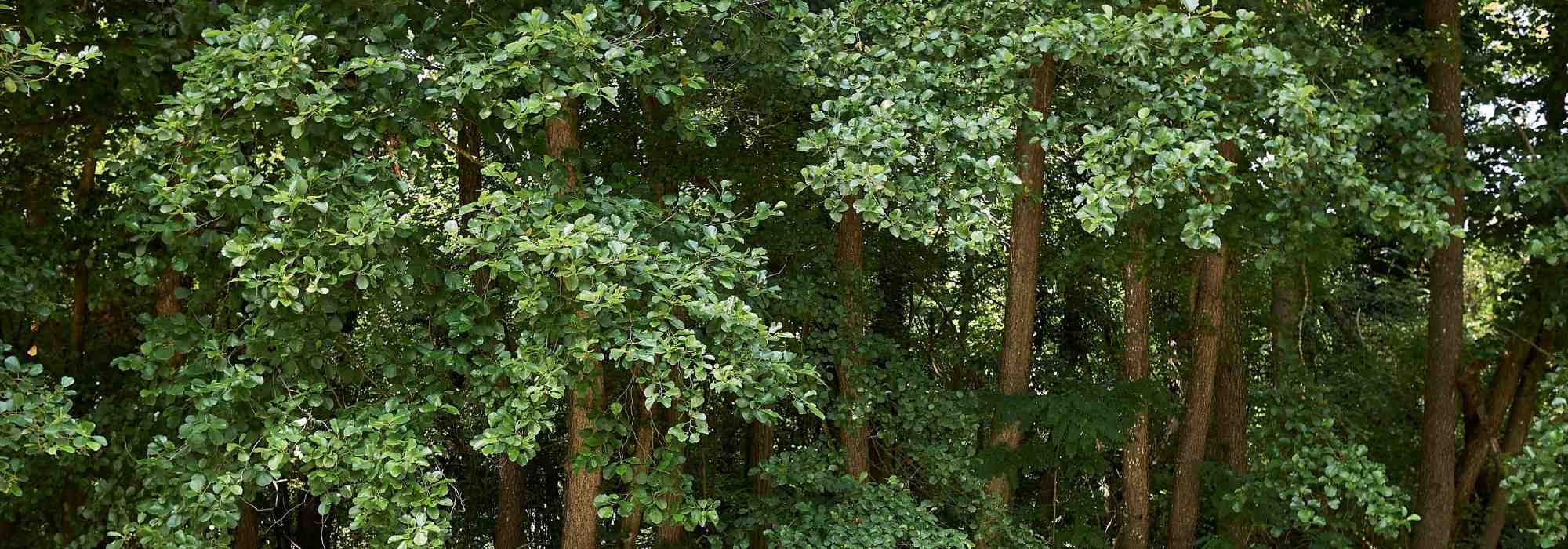
The alder: planting and growing
Contents
The alder in a nutshell
- Alders are typical trees of wet environments
- This is a fast-growing tree that can reach 20 metres, or even more
- The roots of the alder live in symbiosis with nitrogen-fixing bacteria
- The genus Alnus includes around fifty species, mainly distributed in the northern hemisphere
- Alders thrive in sunny locations and moist to wet soil, even if poor
The word from our expert
A typical tree of wetlands, even marshy areas, the alder is a beautiful deciduous tree to adopt in your garden if you have heavy, moist to wet soil. Alders are fast-growing trees with a pyramidal silhouette, capable of reaching around twenty metres, though some are smaller. This is the case with the splendid Alnus glutinosa ‘Imperialis’ with its laciniate foliage.
In France, in the wild, you can find three species: the glutinous alder (Alnus glutinosa), the most common, the grey alder (Alnus incana) in the Alps, and the Italian alder or Alnus cordata in Corsica. These alders are therefore native species.
Alders are also pioneer species: they stabilise riverbanks, enrich the soil with nitrogen, and can host local wildlife. They are also very hardy and rarely affected by diseases.
In the garden, you can plant a beautiful alder as a solitary specimen, in small groups, or to create dense hedges, with some coppicing to encourage regrowth. Alders are decorative in spring thanks to their pendulous inflorescences in aments, during the growing season with their crinkled foliage, in autumn as the leaves turn yellow and purplish buds appear, and even in winter with the strobili, the fruiting bodies, remaining on the branches.
Easy to grow in consistently moist soil, alders generally require little maintenance. They thrive in moist, humus-bearing, even peaty and poor soil, preferably acidic, in full sun or partial shade.
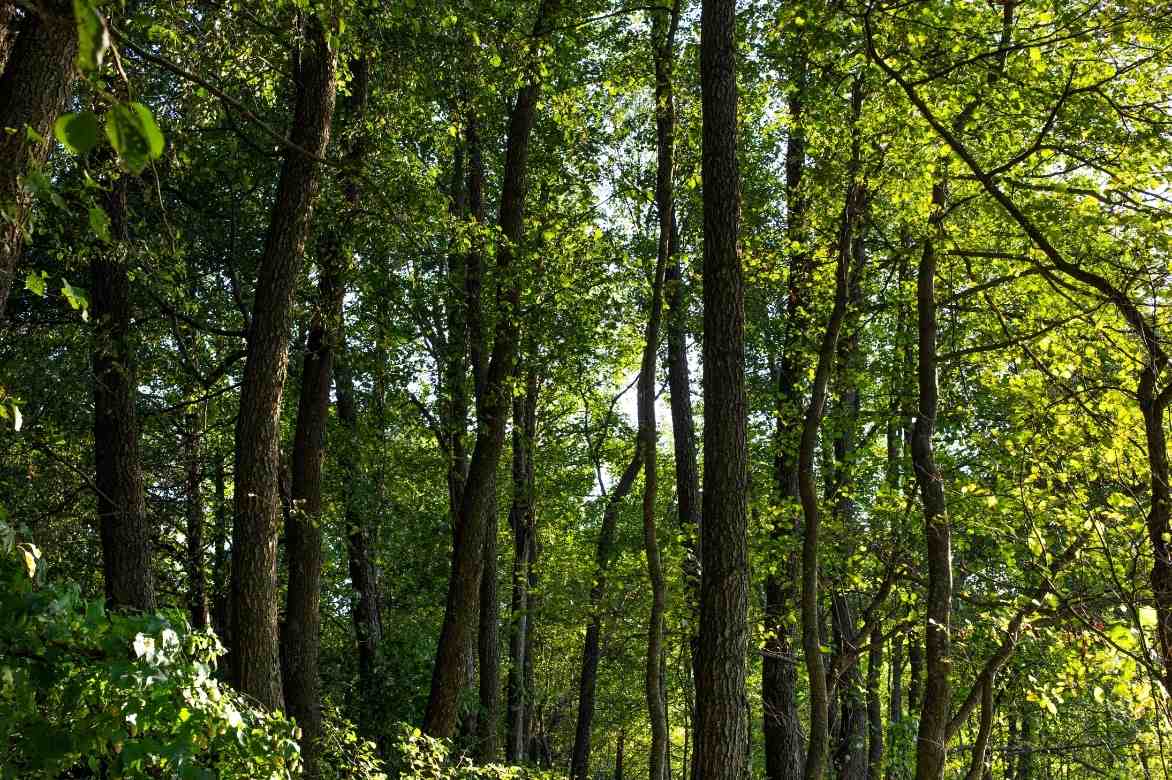
Alnus glutinosa
Botany and description
Botanical data
- Latin name Alnus sp.
- Family Betulaceae
- Common name alder, common alder, black alder, grey alder
- Flowering March-April
- Height 20 m
- Exposure sun, partial shade
- Soil type clayey, moist to fresh
- Hardiness beyond -15°C
Alders are trees belonging to the Betulaceae family, primarily growing in the northern hemisphere on moist soils. The genus Alnus comprises around fifty species, the most well-known among us being Alnus glutinosa or the Common Alder, Alnus incana or the Grey Alder, and Alnus cordata or the Italian Alder. Alders are typically found in damp woodlands, even marshy areas, and along riverbanks. A group of alders is called an alder carr.
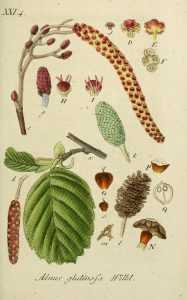
Alnus glutinosa, botanical plate from 1862
Did you know? You might sometimes come across the species name “alnifolia” in the Latin names of certain plants. For example, in the case of Clethra alnifolia. “Alnifolia” simply means “with alder-like leaves“.
Alders are generally deciduous trees, of medium size (20 to 30 m). Only a few species have evergreen or semi-evergreen foliage and grow in subtropical forests. The foliage is alternate, usually dark green in colour. The leaves turn yellow in autumn before falling late in the season. In the Common Alder, the buds are purple and sticky.
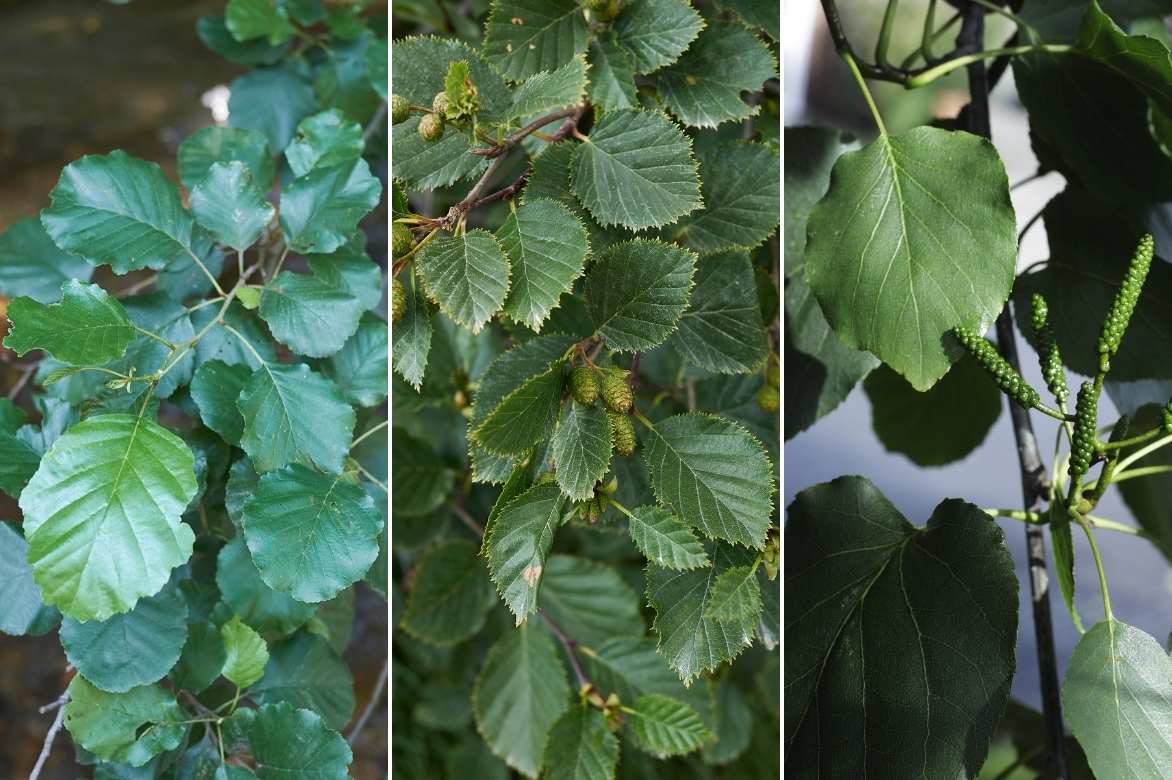
Leaves of Alnus glutinosa, Alnus incana, and Alnus cordata
The alder lives in symbiosis with around twenty mycorrhizal fungi. Additionally, the alder develops nodules on its roots housing bacteria of the genus Frankia. These bacteria fix nitrogen from the air, thereby enriching the soil around the roots. Thanks to this, the alder is considered a pioneer species. The tree “prepares the ground” for other plants to establish themselves. The lifespan of an alder is approximately 60 to 80 years.
Alder wood is light, soft, homogeneous, and rot-resistant. However, outside of water, alder wood degrades very quickly. Alder wood is still used today for making pontoon pilings. In fact, the city of Venice was built on alder wood pilings. Alder wood features enlarged lenticels that aid in tissue oxygenation.
The spring flowering, from late February to early April, consists of flexible, pendulous male and female inflorescences: the catkins. Alders are monoecious, meaning male and female flowers are found on the same tree. The catkins hang at the tips of the branches: the female catkins are purple and located at the base of the male catkins.
Once pollinated, the female catkins transform into small woody cones called strobili, housing the seeds, which are winged achenes. These seeds are particularly favoured by granivorous birds such as the European Greenfinch, the European Goldfinch, and the aptly named Siskin. These birds disperse the seeds, but the seeds are also carried by wind and water.
Good to know: the Common Alder is a particularly important species in the ecology of natural habitats surrounding certain watercourses. This area is called the riparian forest. The riparian forest encompasses the wooded and/or grassy zone along small watercourses and serves as an ecotone, i.e., a transitional zone between two different ecosystems. These transitional zones are always interesting in terms of biodiversity, as they bring together representatives of the flora and fauna from two different types of ecosystems (this is known as the “edge effect“). The alder plays its role as a bank stabiliser, nitrogen fixer (soil enrichment), pollutant remover, and, of course, a shelter and food source for wildlife (notably for the caterpillar of the Purple Emperor – Aparura ilia).
Our most beautiful species and cultivars
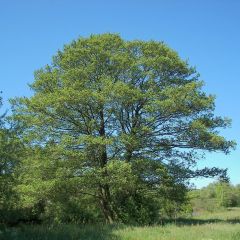
Alnus glutinosa
- Flowering time February to May
- Height at maturity 25 m
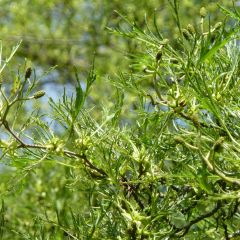
Alnus glutinosa Imperialis
- Flowering time April, May
- Height at maturity 9 m
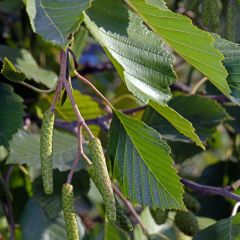
Alnus incana
- Flowering time March to May
- Height at maturity 20 m

Alnus cordata - Italian Alder
- Flowering time April, May
- Height at maturity 25 m
Discover other Alnus - Alder
View all →Available in 1 sizes
Available in 1 sizes
Available in 2 sizes
Available in 1 sizes
Available in 1 sizes
Available in 1 sizes
Available in 1 sizes
Available in 1 sizes
Available in 1 sizes
Available in 1 sizes
Planting the alder
Where to Plant?
Thanks to its ability to fix nitrogen, the alder thrives in poor soils. These trees require soil that remains cool, even moist. In fact, they are among the few trees (along with willows) in our regions that can grow in marshy or regularly flooded ground.
Note that the Alnus cordata or Italian alder tolerates dry and chalky soils much better than the white and glutinous alders.
Alders grow faster and more harmoniously in full sun. They tolerate partial shade or, at a stretch, full shade, but this comes at the expense of their habit and longevity.
When to Plant?
Alders are planted in November-December or in spring, in April.
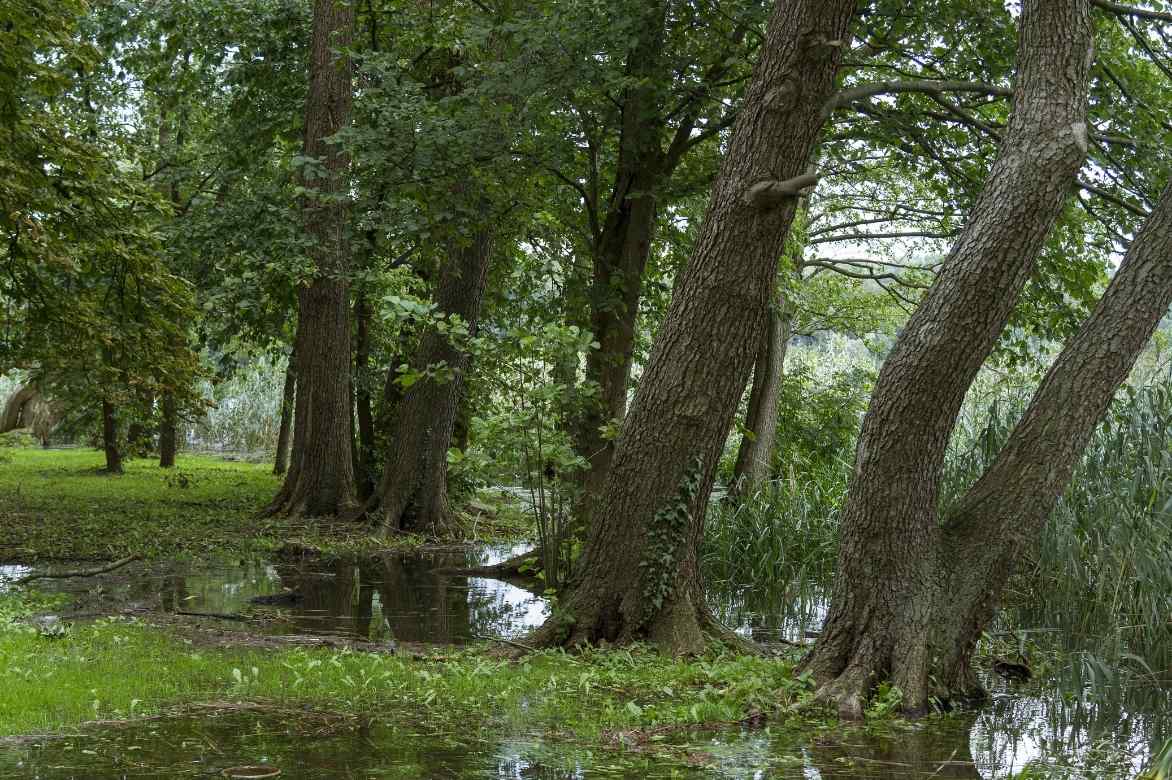
Alders in flooded terrain near a watercourse
How to Plant?
Bare Root (Autumn Planting)
- Dig a hole twice the volume of the plant’s roots. To respect the different soil layers, create one pile with the topsoil (rich and fertile soil) from the first 25-30 cm of depth. Then, make a second pile with the soil removed beyond 30 cm depth;
- Loosen the soil at the bottom of the planting hole. Add compost or potting mix and blend;
- A bare-root tree must be staked. Determine the direction of the prevailing winds—the stake should face this direction to help the tree withstand the wind. Place it at the edge of the hole, not the centre;
- Position the tree or bush upright;
- Refill the planting hole first with the soil from the second pile, then with the fertile soil;
- Level the soil and firm it with your foot to ensure the soil adheres to the roots and eliminates air pockets;
- Secure the tree to the stake with your choice of ties (coconut twine, rubber strap). Do not tie too tightly, as the trunk will thicken during growth;
- With the remaining soil, create a watering basin around the base of the tree or bush;
- Water generously until the soil can no longer absorb water;
- Apply a layer of mulch 7 to 10 cm thick. This acts as winter protection, maintains consistent moisture, and prevents weed growth in early spring.
In Containers
- Soak the root ball in a bucket of water to rehydrate it. Then remove the plant from its pot;
- Dig a planting hole two to three times the size of the root ball;
- Add one to three spadefuls of well-rotted compost;
- Place the plant in the planting hole;
- Backfill with soil and lightly firm;
- Water generously until the soil can no longer absorb water;
- Spread a layer of mulch around the base to maintain good moisture around the roots. This will also limit weed growth.
Maintenance of the Alder Tree
Maintenance simply involves monitoring watering during the first year if rainfall is insufficient. Subsequently, and if the alder has been planted in suitable soil, the tree will manage on its own.
Pruning can be done in late winter (February-March). Some cut back alders during this period to form coppice shoots. Alders, in fact, readily sprout from the stump.
→ Read more: How to prune an alder?
Propagation of the Alder
By Sowing
- Sow seeds in April-May in a substrate half garden soil and half compost, in a tray or pot. Sowing can also be done directly in the ground in loosened soil;
- Lightly cover the seeds;
- Keep the substrate or soil moist until germination;
- Transplant the young plants (10-15 cm tall) into larger pots. Keep your young plants in pots for a full year;
- Plant in autumn the following year.
Note: Alder seeds do not age well; they must be fresh for maximum germination rates—no more than one year old!
As alder is a pioneer species, spontaneous seedlings are very common. In this case, you can simply dig up young plants to relocate them elsewhere in your garden.
By Propagation by Cuttings
Two options are available to you.
- Semi-hardwood cuttings taken in August: Simply place them either in the ground or in a pot, keeping the substrate consistently moist but not waterlogged;
- Truncheon cuttings* (as with willows and poplars) taken in autumn: Cut branches one metre long, soak the base in water all winter, then plant them in the soil, burying at least 30 cm deep. *Truncheons are a type of giant cutting: 2- or 3-year-old branches, stripped of leaves and twigs, at least 1 metre long, sometimes 2 or 3 metres in the case of willows or poplars, which are planted deeply in the soil.
→ Also read How to Propagate Alder?
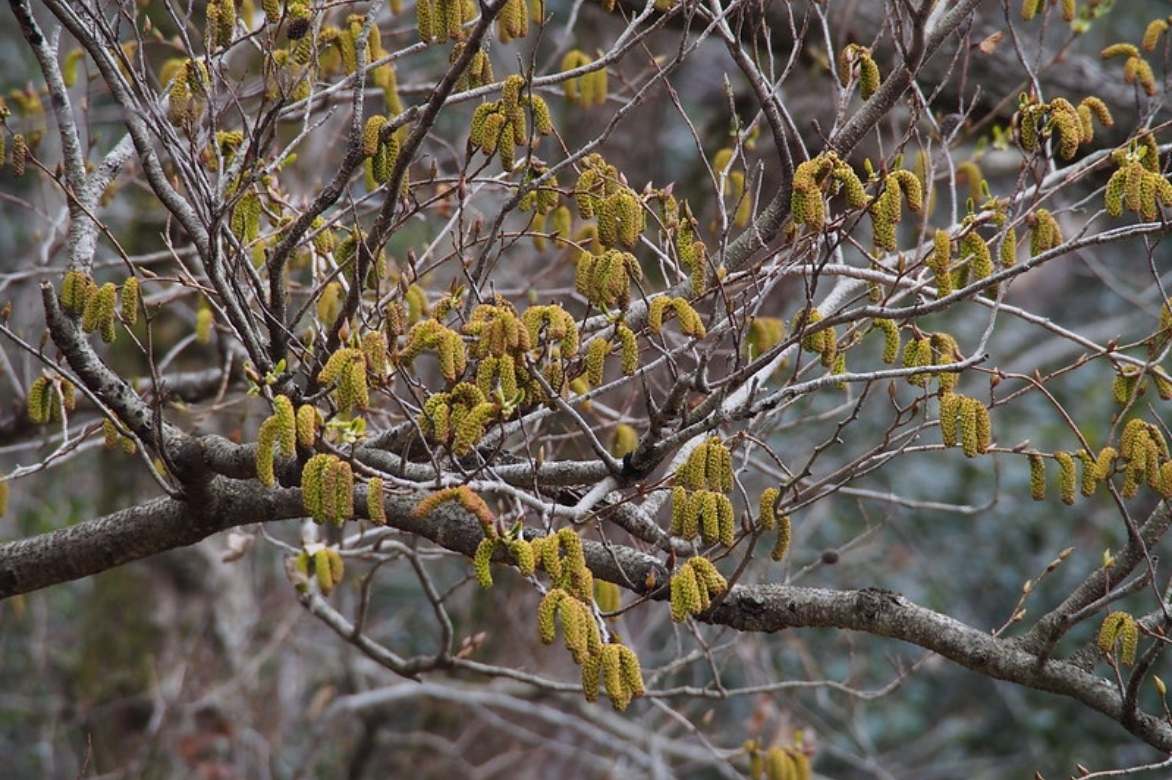
Alnus sieboldiana (©Harum Koh)
Pests and Diseases
Phytophtora alni or Alder Decline Disease
Phytophtora alni is a fungus that penetrates the roots, lenticels, and wounds of the glutinous alder and the white alder. It thrives in warm stagnant water, clay soils, and an excessive concentration of alders in a confined area. Alder decline disease first appeared around 1993. The alder develops yellowed and sparse foliage, and black spots appear on the trunk. There is no treatment, but coppicing can sometimes restore vigour to the tree. Note that this disease is mainly found in natural riparian forests but is relatively rare in our gardens.
Alder Leaf Beetle (Ageslastica alni)
Also known as the Alder Flea Beetle, the alder leaf beetle is a small beetle that “attacks” the leaves of the glutinous alder and the white alder. The eaten leaves take on a lacy appearance. They turn brown and fall quickly. However, there’s no need to worry—the alder tolerates this damage well and will quickly compensate by increasing its photosynthesis rate.
Moreover, it has been proven that alders, when attacked by leaf beetles, release ethene. Nearby trees are then “warned” of this pest attack and increase their defences by raising the concentration of tannic acid in their leaves. Consequently, if one alder is heavily attacked, nearby trees remain virtually unscathed.
Lesser Purple Emperor (Aparura ilia)
Nothing alarming here—quite the opposite! The alder is the host plant for a magnificent butterfly: the Lesser Purple Emperor. The caterpillar also feeds on willows and poplars. Due to climate changes and the decline of its natural habitat, this butterfly is becoming rarer across Europe. So, if you spot these caterpillars on your alders: leave them be! In any case, the alder doesn’t suffer unduly from them.
→ Learn more about alder diseases and pests in our advice sheet.
Combining Alder in the Garden
The Alnus glutinosa ‘Imperialis’ is probably one of the most beautiful alders to adopt in the garden. Its foliage, divided into narrow, pointed lobes, almost resembles fern fronds. Its brown branches are adorned from March with numerous pendulous yellow-green to brown aments, which are highly decorative. Suited to medium-sized gardens, this small tree (no more than 10 m tall and 3 m wide) has a very elegant pyramidal habit.
To do it justice, it should be grown as a solitary specimen. However, this doesn’t mean its base can’t be adorned. Coloured-wood dogwoods are perfect companions for alders. They thrive in heavy, damp soils. A few plants of Cornus sanguinea ‘Magic Flame’, whose green-yellow foliage turns orange in autumn, would be an excellent choice. These vibrant colours will enhance the soft green foliage of the ‘Imperialis’ alder.
For ground cover, opt for understated yet effective perennial ground covers. A few Carex morrowii ‘Irish Green’, with their evergreen, very glossy green foliage, and perhaps a lesser-known plant: a carpet of Veronica repens ‘Sunshine’, a charming little creeping perennial with golden foliage. This luminous carpet of creeping speedwell will persist more or less depending on the harshness of winter and will come alive in late spring, albeit briefly, with delicate little white flowers.
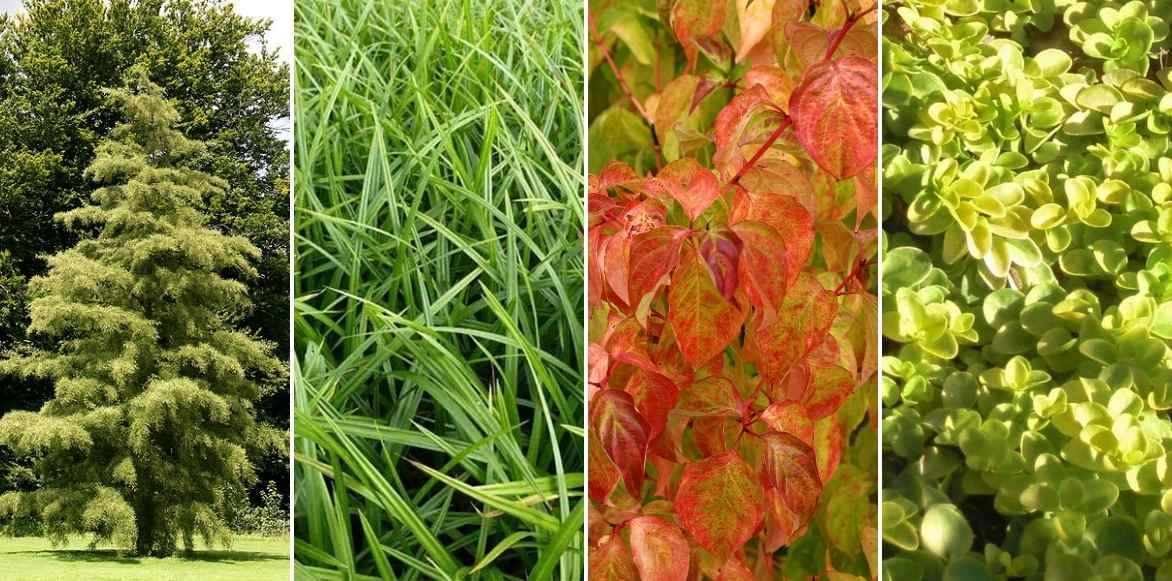
Alnus glutinosa ‘Imperialis’, Carex morrowii ‘Irish Green’, Cornus sanguinea ‘Magic Flame’, and Veronica repens ‘Sunshine’
Did you know?
- The alder is sometimes called “Vergne” or “Verne” in the south of France. This name is a common surname in certain regions of France, as evidenced by the French racing driver Jean-Eric Vergne, nicknamed “Jev“;
- The alder is the name of the 9th day of the month of Germinal in the Republican calendar;
- There is a saying involving the alder: “If the alder greens before the birch, then the summer will be wet; if the birch overtakes the alder, then the season will be dry“;
- The glutinous alder is one of the trees that make up the sacred grove of the druids in Celtic tradition;
- The last glaciation, which ended in our region around 12,000 years ago, drastically reduced the European flora. Alders were among the pioneering essential oils that helped repopulate the north-western part of Europe;
- Alder wood becomes almost rot-proof once soaked in water. This is why it was widely used in the construction of stilts in the Netherlands and Venice, where the city still stands thanks to thousands of alder poles;
- This rot-proof wood is also used for creating breakwaters, formwork, clogs, barrels, or even for making canoes among Native Americans (Alnus rubra or Red Alder);
- Alder wood can also be carved and, thanks to its acoustic characteristics, used in lutherie;
- Alder sawdust is still used today for smoking meat and fish;
- The bark of the alder was used for tanning and dyeing leather.
Also worth reading
- Discover all our alders in our online nursery and the White Alder ‘Monstrosa’: the twisted tree that enhances small gardens.
- How to choose an alder: all our tips for finding the ideal tree for your garden
- Discover the Alnus glutinosa ‘Imperialis’: a small tree with an elegant habit
- How to garden in heavy and wet soil?
- How to determine the nature of your soil?
- Subscribe!
- Contents


































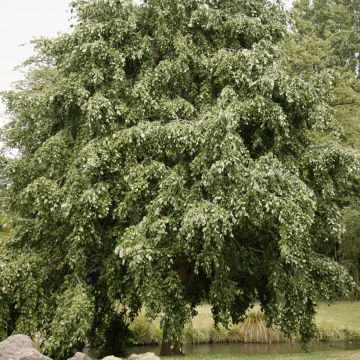

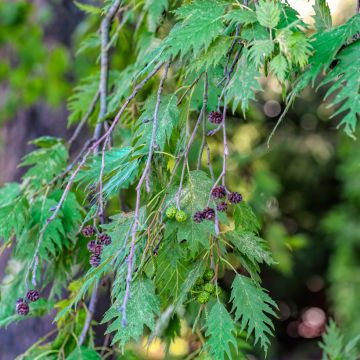
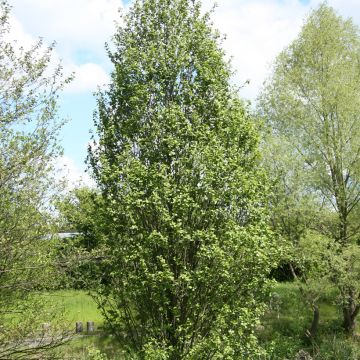
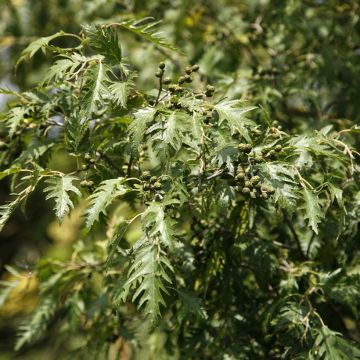

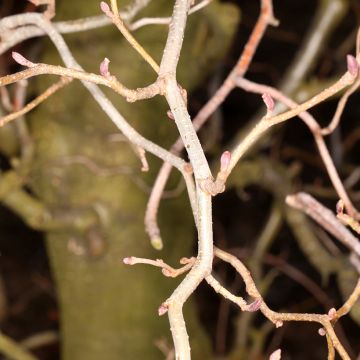
Comments